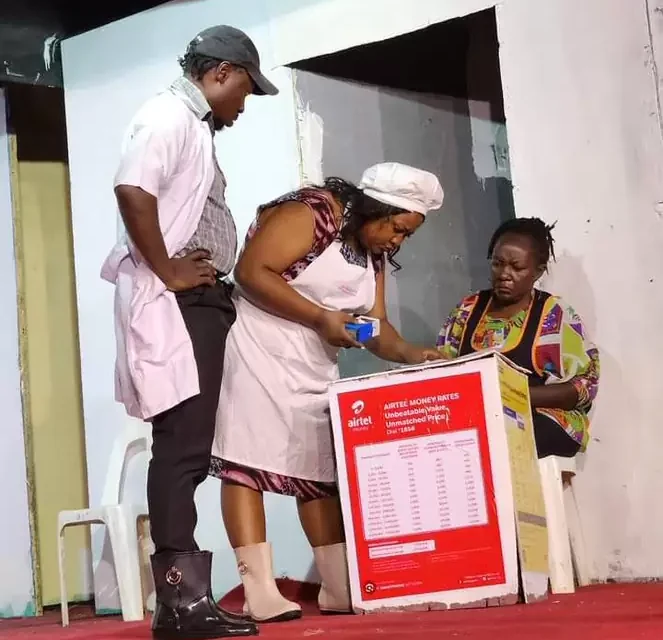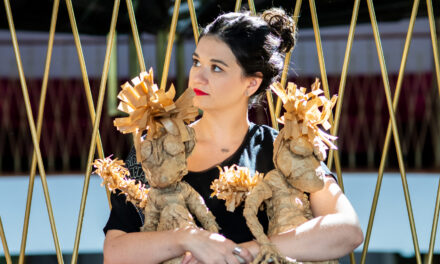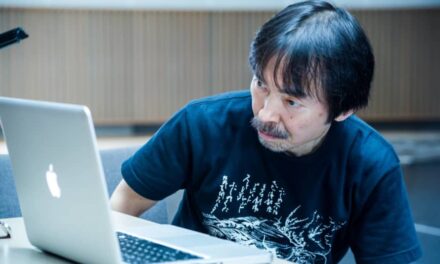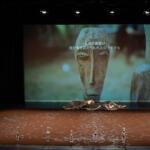If there is one thing many theatre practitioners around the world seem to agree on, it is that the art seems threatened.
Alternative entertainment options like cinema, television, bars, and the internet pose a threat to it. Most people today have more reasons not to go to the bar, yet they will still have fun and interact with different people.
Whether it is Europe or the Americas, people who care about theatre as an art are trying to understand what really went wrong and how they can help it get back on its feet.
Uganda is not any different. These discussions were continued at the two theatre festivals that happened in Uganda in November.
Mariam Ndagire’s Theatre and Performing Arts Festival
Institutes and individuals have discussed the fate of theatre and how things got so bad; in fact, it was the reason Mariam Ndagire started organising the Theatre and Performing Arts Festival in 2022.
The festival took place at Bat Valley Theatre, holding a number of panel discussions and about five productions a day. Big on the panels’ agenda was getting theatre out of limbo, a topic that had a panel of Abbey Mukiibi, Mariam Ndagire, Andrew Ssebaggala, and Aganza Sanyu Kisaka, among others.
See also: Miangaly Theatre Company: Defining the Stage in Madagascar
There were many issues presented in the discussion about theatre and its position in Uganda, plus the elements that have driven people away over the years. One of the issues that came up was the fact that theatres failed to adapt to the changing times, not changing their winning formulas.
For instance, Bat Valley Theatre was the home of Afri-Talent, which drew a lot on the popular faces of Abbey Mukiibi, Ruth Kalibala, Mariam Ndagire, and John Segawa, among others. When alternative forms of entertainment, such as music, started digging into their starbase, utilising them as actors in music videos and later inviting them to reprise the roles on stage, theatre was losing ground without noticing it.
But of course that wasn’t all; more theatre stars even became accessible on FM radio’s breakfast and evening drive shows. Suddenly, the audience did not have to wait for the weekend to see Abbey, Patricko Mujuka, or the late Kato Lubwama.
“Some stopped using the script as a guide; in theatre, you cannot run away from the script. There should always be a script for your stage play,” he said.
Kisaka said theatre producers should always think about the audience and their experience, noting that people don’t come back to shows if their past experience wasn’t memorable.
“Audience experience matters a lot inside and outside the theatre. The experience you create for your audience will determine whether they will come back or not. It may be even as trivial as how easy it is for someone to go to the toilets,” she said.
In the same vein, Ssebaggala also noted that experience is important, adding that locations where people put their shows play an important role in this aspect.
See also: Translating the Act: Kenyan Producers Keeping Indigenous Languages in Auditoriums
He emphasised that the accessibility and convenience of the venue, as well as the surrounding amenities, can greatly impact the overall experience for theatregoers. Additionally, Ssebaggala highlighted the significance of creating a welcoming and comfortable atmosphere within the theatre itself, ensuring that patrons feel valued and engaged throughout their visit.
“The location for where you put your play also matters a lot. The experience you give to the people attending will matter if they come back for more,” he says.
Other panel discussions at the festival looked at theatre incorporating technology in marketing, publicity, and bookings.
Besides that, it was also a chance to put on a lot of shows.
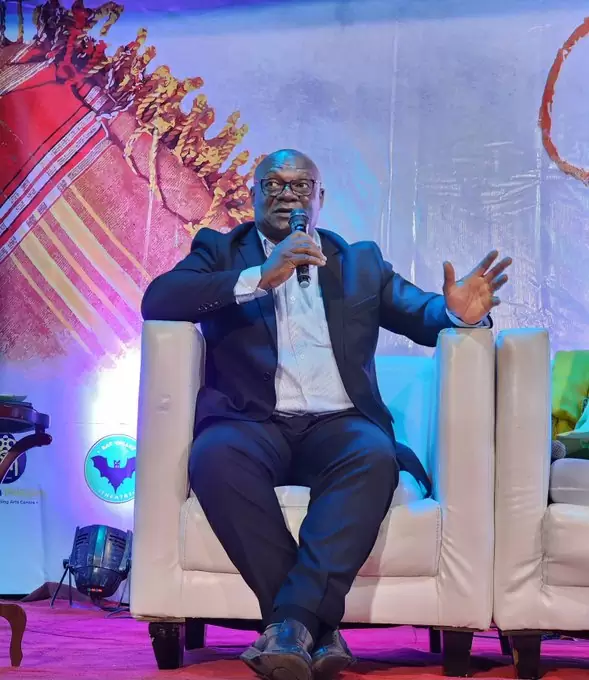
Panelist, actor, Abbey Mukiibi called on producers to keep their shows (Photo by Cinema UG)
Kampala International Theatre (KITF)
Then there was the Kampala International Theatre (KITF); unlike the Theatre and Performing Arts Festival, which was hosting a second edition, this was celebrating a tenth milestone.
Held in three venues—the National Theatre, Motiv, and Ndere Centre—all in Kampala, this year’s edition of the festival was still addressing some of the issues that were heavily discussed by the one at Batvalley.
Because of their longevity, however, they have had a chance to fall and rise so many times that, besides pointing out the issues causing the crisis, they have started being a solution.
For instance, Deborah Asiimwe, one of the directors of KITF, said the reason for the many venues was because each of them represented a different audience that may be neglected whenever theatre is hell bent on happening in familiar spaces.
By having multiple venues, the festival was able to reach a wider range of people and cater to different interests and demographics. This approach allowed for greater inclusivity and ensured that no audience is left behind in the celebration of theatre.
See also: Bwanika Sseremba’s Come Good Rain Finally Comes to Uganda
It is a good move for theatre, but it also introduces challenges. For instance, besides the National Theatre, which is soundproofed and always ready for theatre performances, Motiv and Ndere Centre were not up to the task. These challenges fell on the performers, some of whom came to the festival expecting to put on a show in an auditorium.
“But with Africa and theatre festivals, you have to get ready for whatever comes; we still put up a show, and it was amazing that the public liked it,” noted a performer from Zimbabwe after staging a show at Motiv.
The shows staged also did a lot to address some of the things that were addressed by panelists, such as Abbey Mukiibi, who called on producers to keep their shows under three hours because the audience today easily loses attention.
Most of the shows at KITF, such as Kagayi Ngobi’s But She Wanted It, were between 45 minutes and an hour, while the longer plays also did not go beyond two hours.
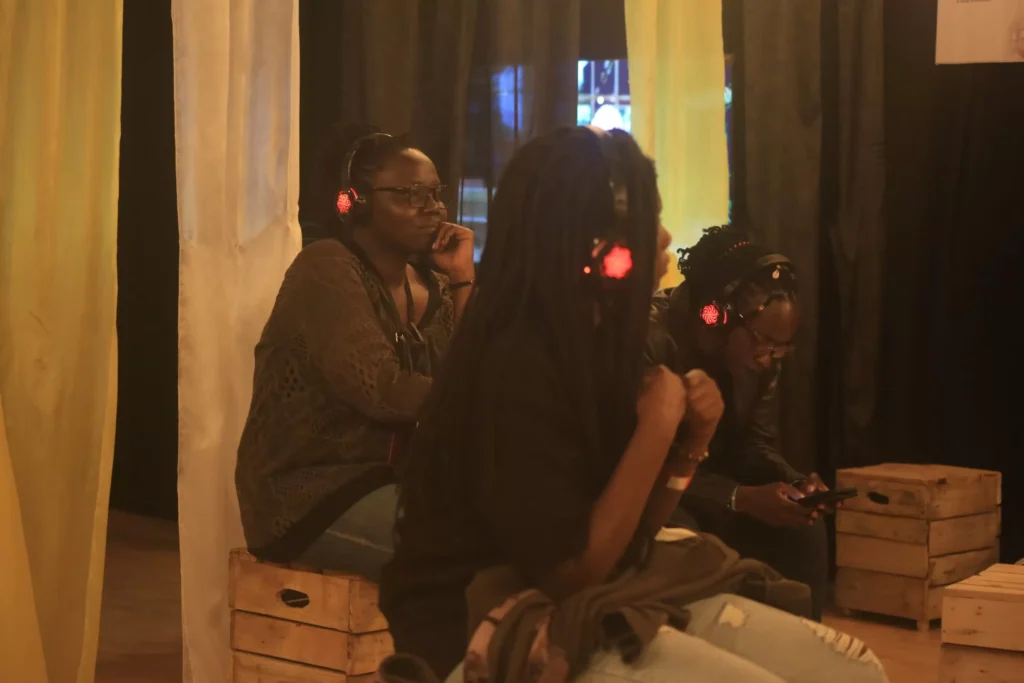
Audiences at the Kampala International Theatre Festival listen to an audio-play installation (photo by Andrew Kaggwa)
Of course, the audience that comes to theatre is changing, as are the different producers. For example, where most African shows depended on the delivery of the actors, shows from the west incorporated a lot of multimedia, such as music, video, and graphics, among others.
Such shows seemed to engage the audience more than the traditional shows that only involve actors.
This shift in theatrical productions reflects the changing preferences and expectations of the audience. The incorporation of multimedia elements not only adds visual and auditory stimulation but also enhances the overall storytelling experience, capturing and holding the audience’s attention more effectively.
See also: If There is No Message, What are We Doing in the Theatre? – Paul Ugbede
Both festivals were interested in audio drama, and like last year, there was yet another audio installation at KITF with plays by up-and-coming authors. The Tebere Arts Foundation will also be producing a podcast as a continuation of this.
At the end of it all, both festivals are looking at the future, how to get theatre out of slumber, how this happens with meagre funding, and a world where art is fighting against the invasion of artificial intelligence. That’s all a story for another day.
This article appeared in The African Theatre Magazine on December 23, 2023, and has been reposted with permission. To read the original article, please click here.
This post was written by the author in their personal capacity.The opinions expressed in this article are the author’s own and do not reflect the view of The Theatre Times, their staff or collaborators.
This post was written by Kaggwa Andrew Mayiga.
The views expressed here belong to the author and do not necessarily reflect our views and opinions.

